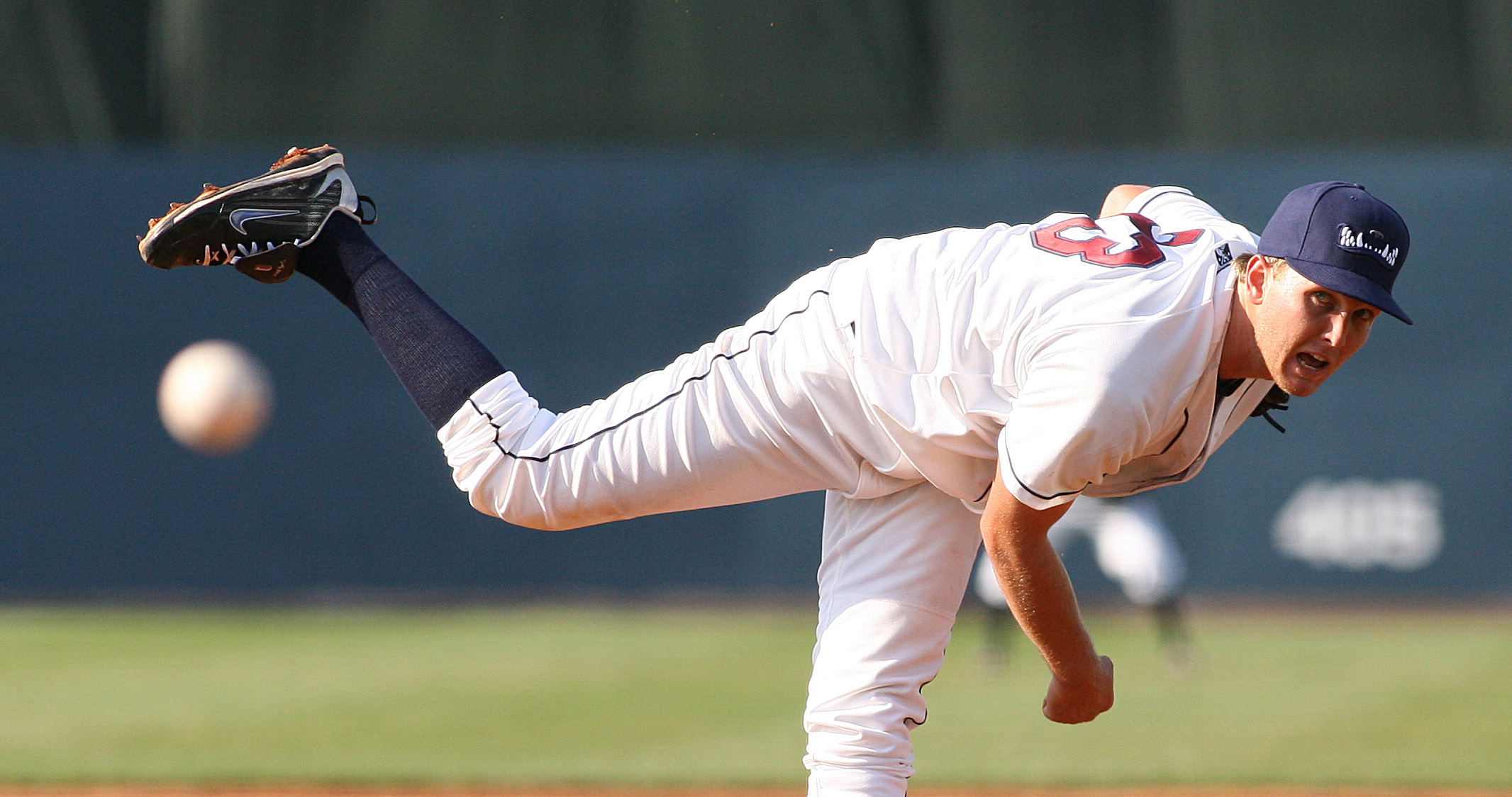 Day two of the prospect countdown rolls on, and today we'll tackle the #55-51 prospects in the system. We'll look at a soft-tossing righty, the Cook twins, the best moustache in the organization and a catcher-turned-first baseman who needs to improve his power output to regain some of his prospect standing. We're barely two days into the countdown, and I'm already second-guessing myself on whether or not I have at least one guy ranked too low on this list.
Day two of the prospect countdown rolls on, and today we'll tackle the #55-51 prospects in the system. We'll look at a soft-tossing righty, the Cook twins, the best moustache in the organization and a catcher-turned-first baseman who needs to improve his power output to regain some of his prospect standing. We're barely two days into the countdown, and I'm already second-guessing myself on whether or not I have at least one guy ranked too low on this list.
55. Mason Radeke, RHP
DOB: 6/13/1990
Height/Weight: 6-1/175 lb.
Bats/Throws: Right/Right
Acquired: 35th round pick in the 2011 MLB draft
2012 Stats: 8-7 with 1 SV and a 3.28 ERA with 119 K and 26 BB in 115 1/3 IP between Akron and Lake County
Scouting Report: Radeke was selected in the 35th round out of Cal Poly in 2011, and signed early enough to throw 43 2/3 innings in 9 starts for the Scrappers that same year. He spent the majority of 2012 with low-A Lake County, but did appear in 3 games for the Aeros. He threw 6 innings in AA, allowing just 1 ER and striking out a pair. With the Captains, he put up a 3.38 ERA in 109 1/3 innings, striking out 117 and walking just 24. He began the season in the bullpen, but transitioned to the rotation mid-year and went 2-5 with a 3.68 ERA as a starter. It was an impressive performance for Radeke in his first full professional season, one that the 22-year old Radeke will need to build on in 2013 to stay on track with respect to his age and level.
Despite the solid strikeout numbers, Radeke is more of a command and control guy than a hard throwing K machine. His fastball sits in the high 80’s, and has some natural sink and nice arm side run. He also throws a curve, slider and changeup, and he commands all four pitches well. He is comfortable throwing any of them in any count, and it helps him keep hitter off balance because they never know what’s coming. He walked just 2 batters per 9 IP last season while striking out 9.3, so it’s clear that when he’s locating his pitches he can get low-A hitters out pretty consistently.
As Radeke rises through the organizational ranks, it’s going to be tougher and tough for him to get by on command and control alone. His fastball velocity is below average, and it’s tough for RHP who don’t crack the 90 MPH barrier to make it to The Show. Still, he’s done everything the Indians have asked him to so far in his career, so it’s hard to just completely dismiss the results he’s been able to produce. He’ll likely begin 2013 with high-A Carolina, and the Carolina League hitters will test his ability to locate all four of his pitches very early on.
Glass half-full: A back of the rotation starter
Glass half-empty: A swingman out of the bullpen
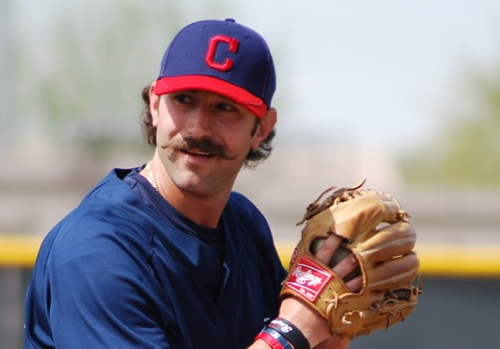 54. Eric Berger, LHP
54. Eric Berger, LHP
DOB: 4/22/1986
Height/Weight: 6-2/205 lb.
Bats/Throws: Left/Left
Acquired: 9th round pick in the 2007 MLB draft
2012 Stats: 2-9 with a 5.27 ERA, 99 K and 37 BB in 111 IP between Columbus and Akron
Scouting Report: After splitting the 2010 and 2011 seasons between AAA Columbus and AA Akron, Berger began the 2012 season back in with the Aeros. Berger was primarily a reliever in 2011, as he made just two starts all season. He excelled out of the bullpen for AA Akron, posting a 2.53 ERA in 57 IP for the Aeros. The Indians still thought that Berger could start though, and the mustachioed southpaw began the season in Akron’s starting rotation. After 5 starts in Akron where he went 0-3 with a 4.37 ERA, Berger was promoted to AAA Columbus. He made 13 starts for the Clippers, bouncing back and forth from the rotation to the bullpen. His ERA was a full two runs lower as a reliever than as a starter, and going forward it really makes a lot more sense to me that Berger be allowed to remain in the bullpen.
Berger’s fastball sits comfortably in the low 90’s, and can touch 94 when he reaches back for a little extra. It’s a two-seamer that has some natural sink and arm-side run. He compliments the fastball with a big, sweeping curveball. The curve is Berger’s out pitch, an above average offering that has a lot of 12/6 break. He also throws a slider and a changeup, and the slider is the better of those two offerings. It’s a mid-70’s pitch with sharp, late break, and is especially effective against lefthanded hitters.
Berger makes a lot of sense as a lefty specialist out of the bullpen, and that’s hopefully the role that the Indians are returning him to for the 2013 season. For his career, he’s 21-25 with a 3.91 ERA, with 454 K and 217 BB in 476 2/3 IP. He’s had better overall numbers pitching out of the bullpen, and has struggled overall in his time with AAA Columbus. In various stints with the Clippers over the past three years, Berger has gone 2-8 with a 6.12 ERA. If his stuff can’t translate to the International League, than there’s no way he’s going to find success at the major league level. If he can be used a little more judiciously and put in a position to succeed, I think he can be a solid lefthanded reliever. But if the Indians think he’s going to start, than I think that they’re mistaken. I’m hoping that Berger opens the 2013 season in the Clippers bullpen, but we’ll see how they decide to use him this year.
Glass half-full: A lefty specialist in the show
Glass half-empty: A lefty specialist in AAA
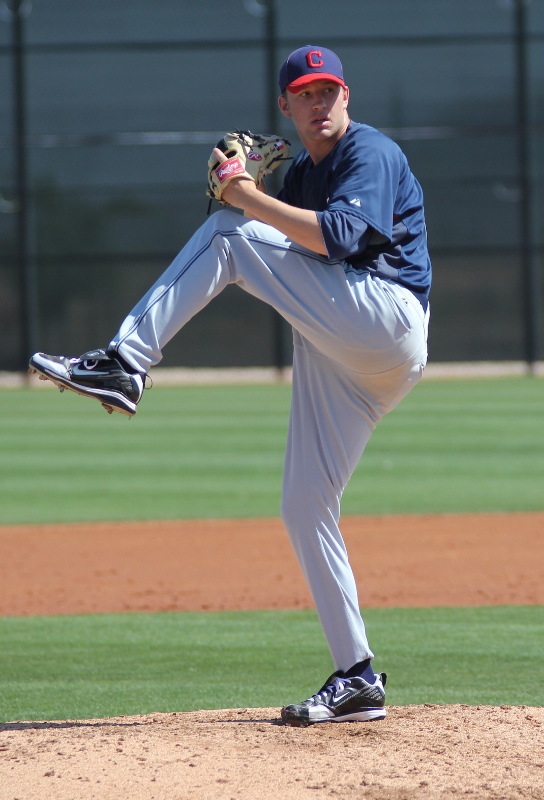 53. Clayton Cook, RHP
53. Clayton Cook, RHP
DOB: 7/23/1990
Height/Weight: 6-3/175 lb.
Bats/Throws: Right/Right
Acquired: 9th round pick in the 2008 MLB draft
2012 Stats: 1-0 with a 2.31 ERA, 8 K and 7 BB in 11 2/3 IP with Carolina
Scouting Report: Cook missed nearly all of the 2012 season with a shoulder injury, throwing fewer than a dozen innings with the Mudcats. He was originally drafted out of a Texas high school in 2008, and the Indians convinced the 9th round pick to forgo his commitment to Oklahoma with a $100,000 signing bonus. In his career, Cook is 22-21 with a 3.57 ERA, and has struck out 7.5 batters per 9 IP.
Cook throws both a two and four-seam fastball, a curveball and a changeup. The four-seamer sits between 91-94 MPH, and has touched 96. The two-seamer tops out at about 92, and has nice arm-side run. His best secondary offering is his curveball, a big, sweeping 12-6 offering that just comes in and falls of the table. It’s his out pitch, and hitters will chase the pitch even as it’s bouncing in the dirt. He’s still getting a feel for his changeup, and it’s a pitch that he was going to work on in 2012 prior to the injury. It has above-average potential, but it’s a pitch that still needs work so he can effectively command it within the strike zone.
Cook is just 22 years old, and even with the lost season in 2012 he hasn’t fallen too far behind the developmental curve. He’s a big, strong kid with a smooth, repeatable delivery and maintains his stuff well throughout his starts. He’s struggled a little in the past with runners on base, and has been susceptible to big innings. He’s a hard worker and a smart pitcher, and his stuff plays up due to his pitchability. The big question for Cook is how effected he’ll be from the injury, and how effective he can be on the mound once he recovers.
Glass half-full: Cook makes a full recovery and works his way to The Show as a backend starter
Glass half-empty: Cook continues to struggle with injuries and never makes it out of the minor leagues
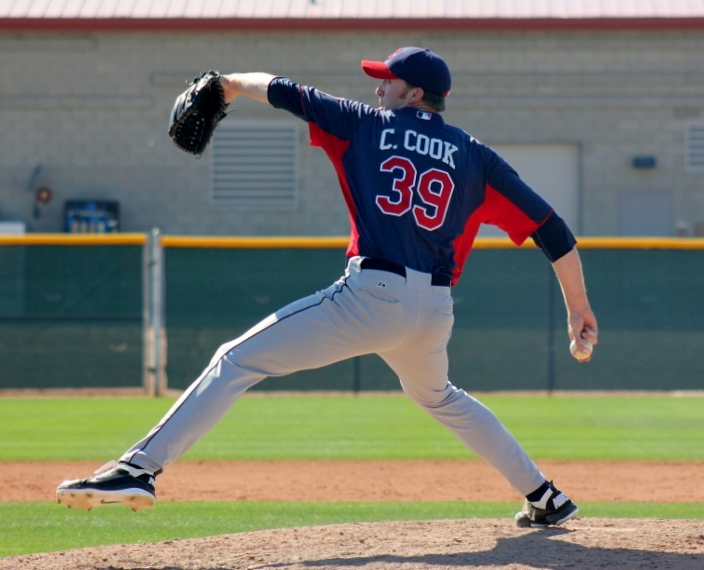 52. Cole Cook, RHP
52. Cole Cook, RHP
DOB: 10/18/1988
Height/Weight: 6-6/220 lb.
Bats/Throws: Right/Right
Acquired: 5th round pick in the 2010 MLB draft
2012 Stats: 2-4, 2.64 ERA with 64 K and 26 BB in 78 1/3 IP between Lake County, Carolina, Akron and Columbus.
Scouting Report: Cook was selected in the 5th round of the MLB draft out of Pepperdine in 2010, and started four games for Mahoning Valley that same year. He spent all of 2011 in Lake County, starting 19 games and going 5-11 with a 4.54 ERA in his first full season as a professional. Cook walked 3 batters per 9 innings in 2011, and struck out just 5.8. It was a slightly disappointing season for the big righty, and he found himself back in Lake County to begin the 2012 campaign. It was a completely different story for Cook in 2012, as he improved on his numbers across the board and by the end of the season he had made stops at every level from Lake County all the way to Columbus.
Cook was transitioned to the bullpen in 2012, and started just three games all season. With his stuff playing up in shorter bursts, Cook was able to strike out more hitters per 9, lower his ERA, WHIP and home run rate. After allowing 16 big flies in 105 innings in 2011, Cook gave up just 5 HR in his 78 1/3 innings last season. After putting up a 3.46 ERA in 22 appearances with Lake County, Cook was promoted to Carolina in June. Cook allowed 5 ER in his first appearance with the Mudcats, but then reeled off 10 consecutive scoreless appearances before finally allowing another earned run in August. After a quick, three appearance stop in Akron (1 ER in 4 1/3 IP), Cook closed out the season with AAA Columbus. In four games (two starts) with the Clip Show, Cook threw 12 scoreless innings, striking out 10 and walking 4. It was a whirlwind tour of the Indians organization for Cook, and a real bounceback season after his rough 2011.
Cook was a weekend starter in college, and throws a fastball that sits comfortably in the low-90’s. He complements the fastball with a splitter, slider and changeup. His best secondary offering is probably his splitter. It has excellent down action through the zone, and generates a lot of groundballs when hitters do make contact with it. Cook really worked on improving his slider between the 2011 and 2012 season, and it was the refinement and development of that pitch that helped him be so much more effective last year.
It will be interesting to see what the Indians have in store for Cook this year; he has a starter’s arsenal, but was much more effective as a reliever last season. Cook is 24 years old, and will likely open 2013 as a swingman in the Akron bullpen. He’ll be an option to spot start if the need arises in either Akron or Columbus, and could easily find himself in the Clippers bullpen by the end of the season. He was one of the most improved players in the system from 2011 to 2012, and if he can make a similar leap in 2013, then he’ll find himself in the top half of this list come next offseason.
Glass half-full: Cook works his way back into the starting rotation
Glass half-empty: Cook sticks as a swingman in the bullpen
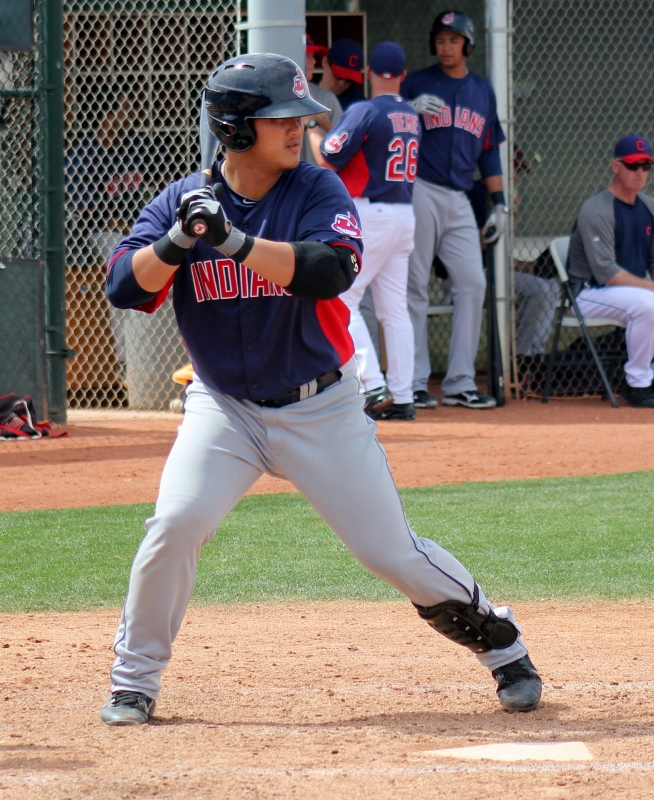 51. Chun Chen, 1B
51. Chun Chen, 1B
DOB: 11/1/1988
Height/Weight: 5-11/210 lb.
Bats/Throws: Right/Right
Acquired: International free agent in 2008
2012 Stats: .308/.394/.426 with 5 HR and 43 RBI in 108 games with AA Akron
Scouting Report: Signed out of Taiwan in 2008, Chen was a 3B when he was signed but the Indians decided to convert him to a catcher. Chen’s bat was always good for the position, but his defense was always behind the bat. Last year, the Indians decided to cut the catcher experiment and moved Chen almost exclusively to 1B with AA Akron. Chen appeared in 62 games at 1B for the Aeros, catching just 8. A funny thing happened in the transition; Chen somehow left his HR stroke behind the plate. After popping 16 HR in 113 games with the Aeros in 2011, Chen managed just 5 in 2012. I really thought the move to 1B would help Chen’s offensive game, as catching takes a heavy toll on a player and it’s much more difficult to hit when you’ve been squatting behind the plate wearing 20 pounds of gear all day. Chen’s batting average did increase 46 points (.262 to .308), but his SLG went down to .426 from .451. That’s a pretty discouraging trend for a player who went from one of the positons on the diamond where you expect the least amount of offense (C) to a place where you expect the most (1B).
At the plate, Chen is a very balanced hitter who does a nice job using all fields. He had a long swing back in 2009, but really worked with the Indians developmental staff to shorten up and get his hands through the zone to handle pitches on the inner half. He’s a career .282 hitter, and is patient enough to have walked his way to a .367 OBP. But his .441 SLG and 37 career HR aren’t what teams are looking for at 1B. His bat would be above average for a catcher, but especially with his power falling off last season it is below average for a 1B.
Defensively, Chen has all of the tools to be an above average 1B. He’s a good athlete with solid feet, and actually has a very strong arm. He made just 3 errors at 1B last season, pretty good for a player learning an entirely new position. His time at 3B as an amateur certainly helped with the transition, and there’s no reason he can’t be a good defensive 1B.
To be considered a prospect at 1B, a player really has to hit. Chen is a good hitter, but he’s not a typical middle of the order masher. I’d like to compare his career minor league numbers to another player for you; again, Chen’s career triple slash line, at the age of 24, is .282/.367/.441 with 37 HR in 428 games. The player I’d like to compare him to (we’ll call him Player B for now) had a .323/.406/.491 triple slash line in the minors at the age of 24, and he hit 34 HR in 332 games. Pretty similar, right? Player B actually had better minor league numbers than Chen. Player B was also a first baseman, and an outstanding defender. That player is none other than the Indians 2012 first baseman, Casey Kotchman. So while it’s possible that Chen carves out a major league career for himself, it’s much less likely that he becomes an impact player now that he’s a first baseman instead of a catcher. Chen will be an option for the Clippers at 1B, but with Matt LaPorta also in Columbus he might find his way back in Akron for a 3rd consecutive season.
Glass half-full: Chen recovers his power stroke and becomes a 2nd division 1B
Glass half-empty: He doesn’t hit enough to make it to The Show as a 1B